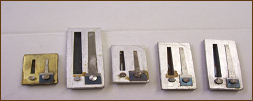|
 |
A World of Accordions Museum houses, displays and restores accordion family instruments, their relatives and predecessors.
What is an accordion?
 The term 'accordion' is the proper generic term for all members of this complex family of free-reed aerophones. Characteristics of all accordions include: (1) metal reed-tongues stimulated by air turbulence; (2) axial alignment to the player's body of one or more mechanical keyboards manipulate by the fingers to select pitches; (3) folded bellows that induce air-flow through the instrument, move horizontally, and are controlled by arm-pressures that in turn regulate the loudness of the sound emitted; (4) straps that hold the instrument in the hands or to the shoulders; (5) encasements that are commonly recognized; (6) ease of portability. The term 'accordion' is the proper generic term for all members of this complex family of free-reed aerophones. Characteristics of all accordions include: (1) metal reed-tongues stimulated by air turbulence; (2) axial alignment to the player's body of one or more mechanical keyboards manipulate by the fingers to select pitches; (3) folded bellows that induce air-flow through the instrument, move horizontally, and are controlled by arm-pressures that in turn regulate the loudness of the sound emitted; (4) straps that hold the instrument in the hands or to the shoulders; (5) encasements that are commonly recognized; (6) ease of portability.
The family is divided into two preliminary halves: "Diatonic" accordions play different pitches when bellows are expanded or compressed; "chromatic" accordions sound the same pitch in both bellows directions. On the diatonic side of the family are Anglo concertinas, Chemnitz concertinas, button diatonics and bandeoneons. On the chromatic side are English concertinas, button chromatics, piano accordions and chromatic bandoneons. All of these instruments contatin many varieties of pitch order and content differences.
Short History of Development
 In general, the development of accordion family instruments shows consistent evolution from simple to complex physlical construction, from elementary to virtuoso musical compositions performable, from basic to highly sophisticated handling and control capabilities. In general, the development of accordion family instruments shows consistent evolution from simple to complex physlical construction, from elementary to virtuoso musical compositions performable, from basic to highly sophisticated handling and control capabilities.
In the year 1829, Cyril Demian of Viena, and later Charles Wheatstone of London, were awarded patents to Akkordeon and Concertina musical instruments, respectively. The Demian model, closely related to an 1822 portable tuning device of Friedrich Buchmann, started the development of the Button Diatonic category of accordions. Wheatstone redefined several types of concertinas that led to the development of others and their relatives, the most well known of which is the bandeoneon.
By the end of the century, many small accordion companies had evolved, notable among them are the names Soprani, Crucianelli, and Dalape. Elaborate abalone inly was used as ornamentation in wood veneers, and later in celluloid.
In the 1930s and 1940s, accordion frames were ornamented by lyre-cut ends, colorful culluloid skins and inset rhinestones. many still-popular manufacturers becamse known n the USA. Numbers of keys and buttons became standardized, interest in reed-banks and shifts increased. Manufacturers imporved their models based on recommendations and endorsements of early virtuosi, made famous through burlesque houses, vaudeville and radio.
By the 1950's, hundreds of brand names were competing with each other, some which experiemnted with unusual keyboard styles. Most were relatively short-lived, but reflected a worldwide passion for the accordion. Millions were imported to the USA, the major marketplace.
By the 1960's, demand for the advanced technological application produced a few instrument models of high sophistication and unusual consistency of tone, notably from the Hohner Company of Germany, a few Italian makers, and Russian bayan production. Development of clear ideals concerning acoustic underlay found expression in the concert instruments, alsmot exclusively piano and button chromatic accordions. Among concert artists, interest in expansion of musical repertory to include masterworks of polyphonic composition had conventionalized the use of free-bass or concvertor instruments. This preference remains valid today.
In America, desire for a wider range of sounds resulted in application of electronic circuitry. By the 1980's many generations of electronic developments resulted in MIDI capabilities. Today, electronic instruments may be very lightweight, of any keying system, produce hundreds of sounds, and in digital instruments, have no reeds!
Accordion production remains varied, carried out in many countries, and the accordion family of instruments remains popualr among young and old, among folk-music, pop-rock, jazz and concert aficonados.
Visitors to the Museum can find the vast variety of accordions organized as follows:
Chronology Section:
Harmonicas/Keyed Harmonicas, Predecessor Instruments,
Demian-type "Flutinas",
Whatstone and Lachenal Concertinas,
Busson Piano Accordions,
Mid 1800s Instruments,
turn-of-the-Century Instruments,
Button Diatonics Predominate,
1930-1950s: Rare and Hybrid Instruments,
Automated Instruments,
Sound-effects Instruments,
Ornate and Impressive,
unusual Accordions,
1960s to present
Synopsis Displays:
Aesthetics and Technology,
World-class Accordions Evolve,
Mordern adn State-of the-Art Models |
|
Organization by Brand-Names:
Uhlig, Band, Busson, Concertone, Lange, Patek, Italo-American, Titano, Pancordion, Pigini, Hohner, Crucianelli, Scandalli, Wurlitzer, Excelsior, Dllape, Galanti, Soprani, Acme and hundreds more!
Organization by Country of Origin:
USA, Russia, Czechoslovakia, Slovenia, Bohemia, Yugoslavia, Hungary, Poland, Denmark, Norway, Sweden, Italy, Finland, Austria, Switzerland, Netherlands, France, Germany (East and West), Mexico, South America, Brazil, Spain, China, Japan, Africa and more!
Organization by Ethnic Styles:
Cajun, Mexican-Conjunto, Old West, Black Performers, American Ethnicities, American Unique
Organization by Special Topics:
Free-bass and Convertor,
Chemnitz Concertinas, Emigres, World War II, USA Makers, Shift Styles, Rock-n-Roll, Jazz, "Musette," Nautical Celluloid, Mail Order Catalogs
Eletronic Accordions Room:
Pedestal Accordion Keyboards, Amplified Instruments, Oscillators to MIDIs |
|